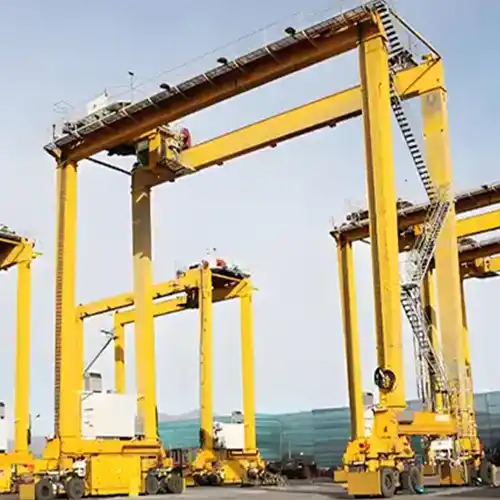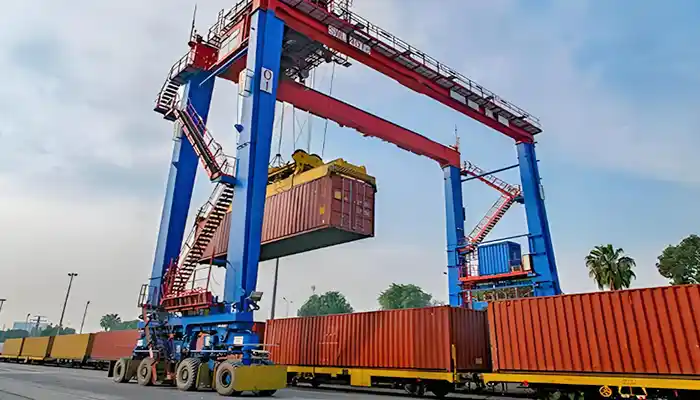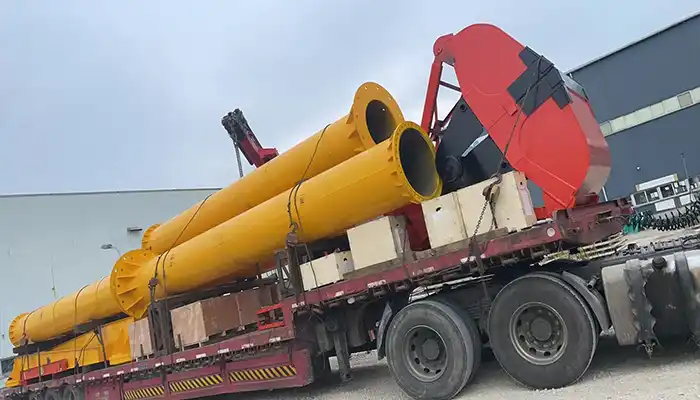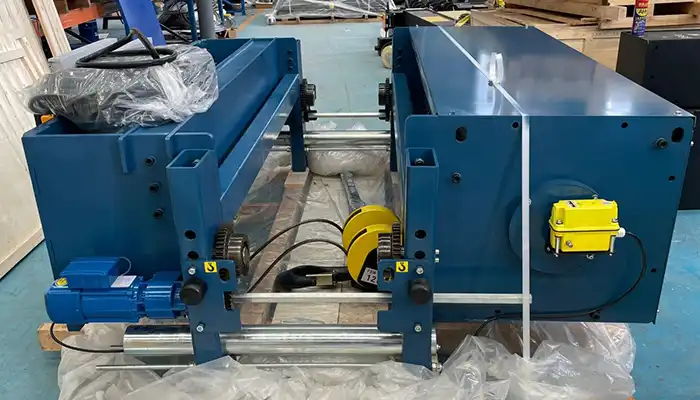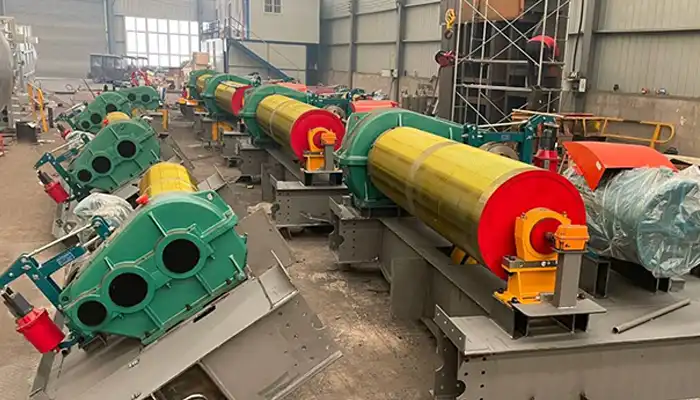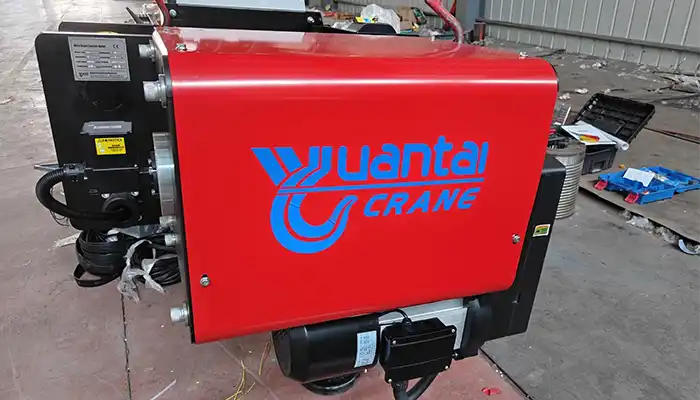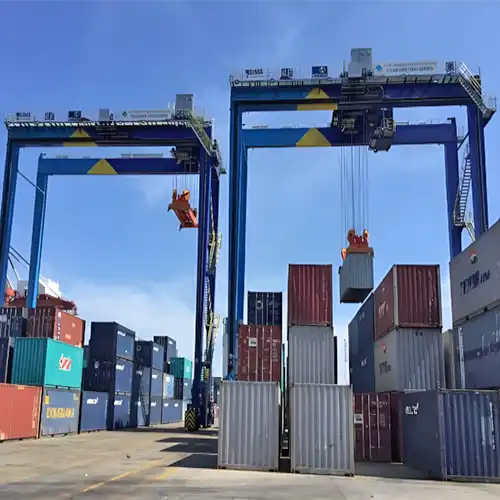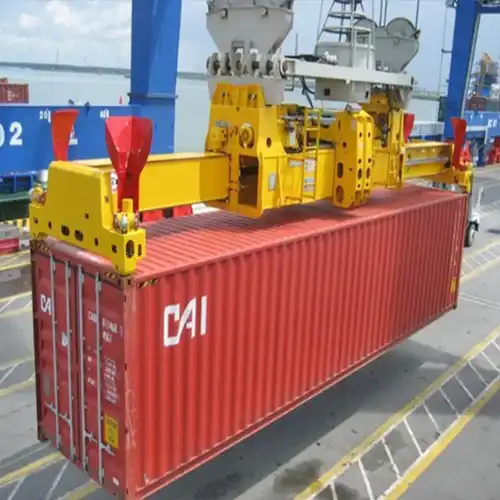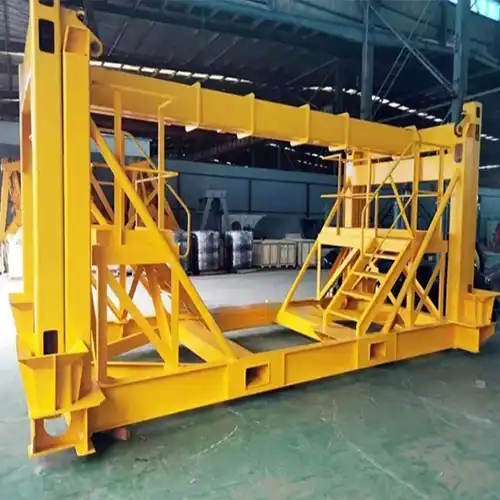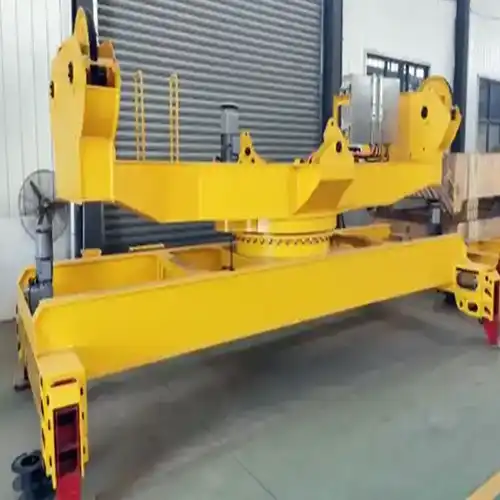Rubber Tyred Gantry Crane for Railroad Container Handling
Customized RTGs efficiently handle container transfers, optimizing intermodal logistics and improving throughput in railroad container yards.
Category: Container Crane
Your Trusted Container Crane Manufacturer & Supplier
Rubber Tyred Gantry Crane for Railroad Container Handling
Customized RTGs efficiently handle container transfers, optimizing intermodal logistics and improving throughput in railroad container yards.
Overview of Rubber Tyred Container Cranes)
What is a Rubber Tyred Gantry Crane? A Rubber Tyred Gantry Crane (Rubber Tyred Container Crane) is a type of crane mounted on rubber tyres, allowing it to move freely within a yard or terminal. Unlike traditional cranes that are fixed to tracks, Rubber Tyred Container Cranes offer the flexibility to move containers in any direction across the yard. They are primarily used for lifting and stacking containers in port facilities, rail yards, and intermodal terminals. With their ability to move freely across large spaces, Rubber Tyred Container Cranes play a key role in the efficient handling of containers.
Rubber Tyred Container Cranes use a gantry structure supported by wheels, which gives them both mobility and strength. These cranes can carry heavy loads, making them ideal for handling railroad containers, where precision and speed are crucial.
Overview of Rubber Tyred Container Cranes in Container Handling
Rubber Tyred Container Cranes are the backbone of container handling in modern ports and rail yards. They are specifically designed to manage large quantities of containers quickly and efficiently. With their ability to stack containers several tiers high, Rubber Tyred Container Cranes help maximize available space in busy yards and terminals. They can pick up containers from rail cars, trucks, or other transportation modes and move them to storage areas or to other transport systems.
In port and rail logistics, Rubber Tyred Container Cranes are essential because they keep operations running smoothly. Without them, container handling would be much slower and less organized. The mobility of Rubber Tyred Container Cranes also allows for easy repositioning, which is critical in dynamic environments like busy docks or rail hubs.

Importance of Rubber Tyred Container Cranes in Port and Rail Logistics
Rubber Tyred Container Cranes offer several important advantages in container handling. Their flexibility allows them to handle containers at various points in a terminal, from rail tracks to storage areas. This flexibility is especially important in large, busy logistics centers where space is limited and high efficiency is required.
They improve operational efficiency by reducing loading and unloading times. The ability to stack containers helps to optimize the storage space and makes it easier to retrieve containers when needed. Rubber Tyred Container Cranes also support fast turnaround times, which is critical for meeting tight schedules in port and rail operations.
Customization in Rubber Tyred Container Crane Design: Why Customized Rubber Tyred Container Cranes are Essential for Railroad Container Handling
While standard Rubber Tyred Container Cranes work well in many environments, the specific needs of railroad container handling often require tailored solutions. Customized Rubber Tyred Container Cranes are built to meet the unique demands of handling railroad containers, taking into account factors like container size, weight, and the layout of the rail yard.
In railroad container handling, it's not just about lifting containers—it's about doing it safely and efficiently in a limited space. Customized Rubber Tyred Container Cranes can be designed to handle containers of different sizes, from 20-foot to 40-foot units, ensuring maximum versatility.
Why Customized Rubber Tyred Container Cranes Matter:
- Adaptability: Customized Rubber Tyred Container Cranes can be designed to match specific yard layouts, rail track sizes, and local conditions.
- Precision: Custom features allow for more accurate handling of containers, reducing the risk of errors or damage.
- Capacity: They can be tailored to handle heavier loads, which is often required in railroad container operations.
Benefits of Customized Features for Specific Applications
Customized Rubber Tyred Container Cranes are built to meet the specific needs of each container yard, which helps optimize productivity. With features like adjustable lifting heights, wider reach, and specialized hoisting mechanisms, they can handle containers more efficiently.
- Maximizing Space: Customized Rubber Tyred Container Cranes can be designed to work in tighter spaces. They can reach higher or stack containers more efficiently to maximize storage.
- Enhanced Safety: Custom safety features, such as sensors and advanced control systems, help prevent accidents and ensure smooth operations.
- Improved Efficiency: The tailored design helps reduce handling time, increasing the overall throughput of containers in the yard.
By meeting the specific needs of railroad container handling, customized Rubber Tyred Container Cranes provide a smoother, faster, and safer process, which ultimately supports better logistics operations.
Applications of Rubber Tyred Container Cranes in Railroad Container Handling
Role of Rubber Tyred Container Cranes in Intermodal Logistics
Rubber Tyred Container Cranes (RTGs) are crucial in connecting different transportation modes, particularly in intermodal logistics. They act as the bridge between railroad systems, ports, and terminals, facilitating the smooth transfer of containers from one transport mode to another.
In an intermodal system, containers are moved by various forms of transport—rail, road, and sea. RTGs are used to load and unload containers from rail cars and transport them to other areas for further handling or storage. Their ability to move freely across the yard allows for efficient transitions between rail tracks and storage zones.
Key Functions in Intermodal Logistics:
- Linking Rail and Port Operations: RTGs pick up containers from trains, move them to staging areas or directly to ships for export. This seamless integration between rail and sea transport is vital for the efficiency of global trade.
- Flexible Container Movement: RTGs are not limited to one specific function. They can handle containers at various points, from rail to truck and beyond, ensuring flexibility in the flow of goods across different transport systems.
The role of RTGs in intermodal logistics is indispensable, as they help to keep supply chains moving efficiently, reducing delays and improving operational coordination between different transport methods.
The Transfer of Containers Between Rail Cars and Storage Areas
In rail yards, RTGs are primarily used to transfer containers from rail cars to storage areas, such as stacking zones. The ability of RTGs to stack containers in multiple tiers maximizes the limited space available in rail yards. These cranes can easily move containers from the train, stack them, and retrieve them when needed—all with high precision.
Process of Container Transfer:
- Container Pick-up: RTGs pick up containers from rail cars as soon as they arrive in the yard.
- Transport to Storage: They then transport the containers to designated storage areas, where containers are stacked for easy access or prepared for shipment.
- Fast Retrieval: When required, RTGs can retrieve containers from the stack and move them quickly to the appropriate transport mode, such as truck or another train.
This transfer process is vital for the smooth flow of containers in a rail yard. Without RTGs, the movement of containers would be much slower, resulting in higher operational costs and longer turnaround times.
Efficiency in Container Handling
Rubber Tyred Container Cranes provide significant time-saving advantages in rail yard operations. Their high speed, flexibility, and precision make them ideal for handling large volumes of containers with minimal delays. The combination of their ability to move freely and their high lifting capacity makes them one of the most efficient cranes for container handling in rail yards.
Time-Saving Advantages of RTGs:
- Rapid Container Handling: RTGs can lift and move containers quickly, which minimizes the time spent waiting for containers to be unloaded or loaded onto transport vehicles.
- Fast Cycle Times: These cranes can handle multiple containers per cycle, which means rail yards can process more containers in a shorter period.
- Reduced Idle Time: RTGs can be moved to different locations within the yard, allowing them to perform tasks without needing to wait for other equipment or cranes to free up space.
The time-saving ability of RTGs helps to speed up operations and improve the efficiency of the entire rail yard.
Impact on Reducing Congestion and Improving Throughput
RTGs play a critical role in reducing congestion in rail yards and improving overall throughput. By being mobile and able to handle containers in different locations, RTGs reduce the bottlenecks that often occur when large quantities of containers need to be processed at once. This capability allows for smoother operations and increases the overall throughput of the facility.
How RTGs Help Reduce Congestion:
- Flexible Movement: Since RTGs are not restricted to fixed tracks, they can move around congested areas and work in multiple spots across the yard. This reduces the likelihood of blockages in high-traffic zones.
- Maximized Space Utilization: RTGs help utilize yard space more efficiently by stacking containers higher and closer together, leaving more space for other activities like loading and unloading.
- Increased Productivity: With their speed and efficiency, RTGs help handle more containers per hour, increasing the overall throughput of the rail yard and improving the overall productivity of intermodal operations.
Reducing congestion and increasing throughput are essential for ensuring that rail yards operate efficiently and meet the growing demands of global trade.
By addressing both the transfer and handling efficiency of containers, RTGs ensure that operations run smoothly in busy rail yards, improving the overall flow of logistics. Let me know if you'd like to dive deeper into any specific points!
Key Features of Customized Container Gantry Cranes
Customization Options
Customized container gantry cranes are designed with adjustable features to meet the unique demands of railroad container handling. Their versatility allows them to handle different container sizes, weights, and operational conditions.
Adjustable Width and Height of the Crane:
- The ability to adjust the width and height of a customized gantry crane is essential for ensuring it can handle containers of varying sizes. Cranes can be modified to reach the required lifting height or span the width needed to pick up containers from rail cars.
- This flexibility is particularly important in environments where containers come in multiple sizes or where stacking heights need to be adjusted to maximize space.
Adaptable Lifting Capacities Based on Container Size and Weight:
- Customized RTGs can be tailored to lift different weights depending on the size and type of the container. Larger containers or heavier loads may require a stronger lifting mechanism, while lighter containers can be managed with lower lifting capacities.
- This adaptability helps ensure that the crane is always capable of handling the container sizes and weights typically encountered at the facility.
Specialized Hoisting Systems for Precise Handling:
- Specialized hoisting systems, such as those with variable speeds or fine control, enable precise handling of containers. These systems prevent accidental damage to goods and improve efficiency by ensuring containers are securely lifted and moved.
- These hoists also ensure that containers are placed accurately in their storage spaces or on other transport systems, minimizing handling time and reducing errors.
Automation and Control Systems
Incorporating advanced automation and control systems in Rubber Tyred Container Gantry Cranes significantly enhances their efficiency, precision, and safety.
Incorporating Remote Control and Automation:
- Remote control systems allow operators to manage the crane's movements and operations from a safe distance, improving safety while maintaining control over the crane's functions.
- Automation, such as automated positioning and load handling, streamlines crane operations by reducing the need for manual intervention. This also decreases human error, making the operation smoother and more consistent.
Benefits of Automation in Improving Operational Efficiency:
- Faster Operations: Automation allows for quicker response times, helping cranes to move containers more rapidly and efficiently across the yard. This speeds up the overall container handling process.
- Reduced Labor Costs: With automated systems, fewer manual operators are required, reducing the cost and potential risks associated with human labor.
- Continuous Operation: Automated cranes can run longer hours with less downtime, improving overall throughput and operational performance.
Safety Features like Collision Avoidance Sensors:
- Safety is paramount in container handling operations. Many customized RTGs come equipped with collision avoidance sensors that detect obstacles or other cranes in the vicinity, preventing accidents and ensuring smooth, safe operations.
- These sensors work in real-time, alerting operators to potential hazards before they can cause harm. They help maintain a safe working environment, particularly in busy yards where multiple cranes and equipment operate simultaneously.
Integration with Other Equipment
Customized container gantry cranes are often integrated with other equipment to ensure smooth, efficient operations within the rail yard.
Compatibility with Rail Systems, Rail Cars, and Container Stacking Systems:
- Customized RTGs are designed to work seamlessly with various rail systems and rail cars, allowing for quick transfer of containers between rail transport and storage or other transport modes.
- They are also adapted to interact with container stacking systems, which are used to organize containers in multiple layers or rows. This integration ensures that the cranes can retrieve or place containers accurately in the designated stacking areas.
Interaction with Other Crane Types and Equipment for Seamless Operations:
- In many operations, multiple types of cranes are used in tandem. For example, an RTG might work in coordination with overhead cranes, reach stackers, or other types of gantry cranes. Customized RTGs can be designed to interact with these cranes efficiently, ensuring that containers are transferred smoothly between them.
- Additionally, compatibility with automated systems, such as container tracking systems and automated guided vehicles (AGVs), ensures that the RTG crane is part of a larger, integrated logistics system.
By ensuring that customized RTGs work well with other equipment, operations in rail yards and ports can be streamlined, leading to smoother, faster, and more efficient container handling.
Design Considerations for Rubber Tyred Container Cranes in Railroad Container Handling
Railroad-Specific Design Features
When it comes to Rubber Tyred Container Cranes (RTGs) in railroad container handling, the design must be specifically tailored to accommodate the unique demands of rail yard operations.
Tailored Design for Railroad Tracks and Terrain:
- The RTG crane is built to navigate the specific track layout of rail yards. This includes adjusting wheel configurations to ensure the crane can move smoothly along the tracks while handling containers.
- The wheels and tires are designed for optimal traction and stability, ensuring that the crane can operate on various track conditions, including uneven or inclined surfaces. This is critical for maintaining safety and precision during container handling.
Adaptations for Varying Rail Yard Layouts and Space Constraints:
- Rail yards come in different layouts, with some having more space than others. A key consideration for RTG design is its ability to function efficiently in these varying environments. The crane can be customized in terms of height, width, and reach to accommodate the available space and meet the operational needs of the yard.
- Some rail yards have restricted areas where space for maneuvering is limited. RTGs can be designed with compact structures or extendable arms to operate within tighter spaces, ensuring maximum efficiency without compromising on performance.
Durability and Maintenance
Given the challenging conditions in rail yards—where heavy-duty handling, environmental factors, and continuous use are common—RTGs must be designed for long-lasting durability and ease of maintenance.
Materials Used for Heavy-Duty Rail Yard Conditions:
- RTGs are built using robust materials like steel and high-strength alloys to withstand the heavy-duty operations in rail yards. These materials are selected for their ability to handle constant use, heavy container loads, and exposure to wear and tear.
- Reinforced components, such as the undercarriage and structural beams, ensure that the crane remains operational even under the most demanding conditions, providing a longer service life.
Anti-Corrosion and Weather-Resistant Features:
- Rail yards often expose cranes to harsh environmental factors, such as extreme temperatures, rain, and high humidity. To combat corrosion, RTGs are designed with anti-corrosion coatings and weather-resistant features that protect the crane from damage.
- Special coatings or galvanized parts are used to prevent rusting and deterioration, especially in coastal areas or regions with high moisture levels. These protective features help ensure that the crane remains operational and safe over time, reducing the need for frequent repairs and extending its lifespan.
Maintenance Requirements for Long-Term Reliability:
- RTGs are engineered for ease of maintenance, with accessible parts that make it simple for technicians to perform routine checks and repairs. Regular inspections of key components, such as the wheels, tires, and lifting systems, are vital for ensuring that the crane remains in optimal working condition.
- Predictive maintenance systems can be incorporated to monitor crane performance in real-time, allowing operators to identify potential issues before they cause downtime. Proper lubrication, periodic inspections, and timely repairs are essential to maintaining the crane's reliability and preventing costly breakdowns.
By focusing on these design considerations, Rubber Tyred Container Cranes are built to meet the demanding requirements of railroad container handling, ensuring durability, efficiency, and ease of maintenance. This tailored approach makes RTGs highly effective in the fast-paced, challenging environment of rail yards.
Performance and Capacity of Customized Rubber Tyred Container Cranes
Lifting Capacity and Reach
The lifting capacity and reach of customized Rubber Tyred Container Cranes (RTGs) are key performance factors that determine their efficiency and suitability for different container handling tasks in railroad operations.
Typical Lifting Capacity Ranges and Reach Specifications:
- Customized RTGs typically offer lifting capacities ranging from 30 tons to 50 tons, which is sufficient to handle the majority of standard containers used in intermodal transportation.
- The crane's reach, which refers to the horizontal distance it can extend to lift containers, can vary depending on the container yard layout and space availability. Typically, RTGs can reach up to 50 feet or more, allowing them to easily pick up containers from rail cars and place them in stacking areas.
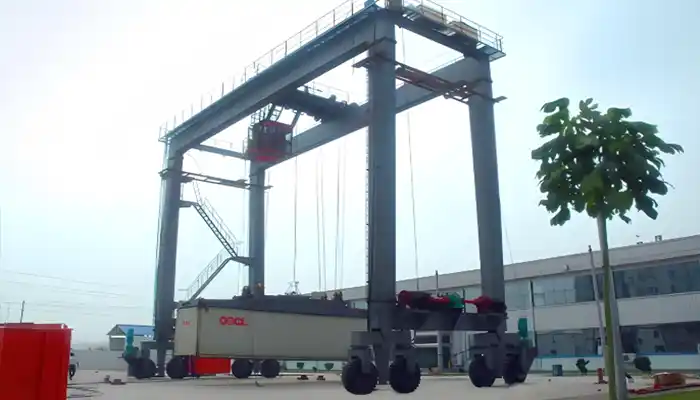
Adjustments Based on Specific Container Types (e.g., 20ft, 40ft Containers):
- RTGs can be designed with adjustable lifting mechanisms to handle containers of different sizes, such as 20ft, 40ft, or even 45ft containers. For smaller containers, the crane may only need a shorter reach or a lower lifting capacity, while larger containers may require the crane to extend further or operate at higher lifting capacities.
- These adjustments ensure the crane can handle a wide variety of container sizes efficiently, without the need for additional equipment or downtime for reconfiguration.
Handling Speed and Cycle Time
Efficient container handling requires quick operation, and the handling speed and cycle time of RTGs play a crucial role in improving productivity and throughput in rail yard operations.
Load/Unload Speeds for Containers and Throughput Optimization:
- RTGs are designed to handle containers with impressive speed. Depending on the crane's specifications and the type of control systems in place, the average cycle time for loading or unloading a container can range from 2 to 5 minutes.
- Automation and remote control systems play a significant role in optimizing the load/unload process, allowing operators to achieve faster cycle times. This speed ensures that containers are quickly transferred between rail cars, storage areas, or other handling equipment, preventing delays and increasing the overall efficiency of operations.
Impact on Overall Logistics Performance:
- Faster handling speeds and reduced cycle times directly contribute to better overall logistics performance. RTGs that can load and unload containers quickly reduce congestion in rail yards and enhance the throughput capacity of the facility.
- This efficiency also reduces waiting times for trains, enabling rail transport systems to run on a tighter schedule. By improving throughput and optimizing cycle times, the crane's performance supports the smooth flow of goods through the supply chain, ensuring timely delivery and minimizing delays.
By optimizing both lifting capacity and handling speed, customized Container Cranes offer significant benefits in terms of container handling efficiency, throughput, and overall logistics performance. These cranes provide reliable, fast, and precise container movement, contributing to more streamlined operations in rail yard environments.
Benefits of Using Customized Rubber Tyred Container Cranes for Railroad Container Handling
Increased Operational Efficiency
Customized Rubber Tyred Container Cranes (RTGs) significantly boost operational efficiency in railroad container handling, offering numerous advantages that enhance the speed and smoothness of operations.
Reduced Turnaround Times for Containers:
- One of the main benefits of using customized RTGs is the reduction in turnaround times. With faster lifting, more precise container handling, and quick positioning, these cranes minimize the time spent on loading and unloading containers. This means rail cars can be swiftly loaded or unloaded, allowing trains to stay on schedule and increasing the overall throughput of the yard.
- This efficiency is crucial in busy rail yards, where every minute saved leads to better productivity and fewer delays.
Enhanced Handling Capacity for High-Volume Rail Operations:
- Customized RTGs are specifically designed to handle high volumes of containers, which is essential for busy rail yards where containers need to be transferred quickly. The cranes can manage multiple containers in a short time, optimizing the overall flow of goods.
- Their lifting capacity and fast cycle times ensure they can handle heavy-duty operations without causing bottlenecks, thus maintaining a smooth and continuous operation even during peak times.
Cost-Effectiveness
The use of customized RTGs in railroad container handling helps improve cost-effectiveness in several key ways, offering both direct and indirect savings.
Reducing the Need for Additional Cranes or Equipment:
- By customizing RTGs to meet specific container handling needs, facilities can avoid the need for multiple types of cranes or other equipment. A well-designed RTG can handle different container sizes and weights, making it a versatile and cost-effective solution.
- This reduces the need for investing in additional equipment, which not only saves on upfront costs but also reduces ongoing maintenance and operational expenses.
Operational Savings Through Streamlined Logistics:
- Customized RTGs streamline operations by reducing downtime, minimizing delays, and optimizing container handling processes. This leads to operational savings, as fewer delays and faster turnaround times translate into lower labor costs and reduced energy consumption.
- The increased automation and control systems also reduce the need for manual labor, contributing to cost savings while improving safety and consistency in handling.
Flexibility and Scalability
One of the most compelling reasons to invest in customized RTGs is their flexibility and scalability, ensuring they can meet the ever-changing needs of railroad container handling.
Adaptability to Different Types of Containers and Rail Systems:
- Customized RTGs are designed to handle a variety of container sizes and types, such as 20ft, 40ft, and oversized containers. Their ability to adapt to different types of rail systems and configurations makes them ideal for facilities with varying layouts or container requirements.
- This flexibility means that the crane can be used for different container handling tasks without the need for frequent adjustments or upgrades, making it a long-term solution for a wide range of operations.
Future Scalability for Growing Operations:
- As operations grow, customized RTGs can be easily scaled up to accommodate increased container volumes or new handling requirements. Whether it's expanding the lifting capacity or adding automation features, these cranes can be adapted to meet future demands.
- This scalability ensures that the investment in an RTG crane pays off over time, as the system can evolve with the business without requiring a complete overhaul of the infrastructure.
By providing increased operational efficiency, cost-effectiveness, and scalability, customized Rubber Tyred Container Cranes offer valuable benefits to rail yards and container handling operations. These cranes ensure that operations run smoothly, with reduced costs and the flexibility to grow with the business, making them an essential asset in modern logistics.
Challenges and Considerations in Implementing Customized Rubber Tyred Container Cranes
Site-Specific Challenges
Implementing customized Rubber Tyred Container Cranes (RTGs) in railroad container handling operations requires addressing several site-specific challenges. These factors are crucial in determining the feasibility and efficiency of crane deployment.
Space Limitations and Terrain Issues in Rail Yards:
- Rail yards often have limited space, especially in older facilities, which can make it difficult to maneuver large equipment. The customization of RTGs must account for these space constraints, ensuring the crane fits within the available area without interfering with other operations or structures.
- Terrain variations, such as uneven ground or inclined surfaces, also pose a challenge. RTGs need to be designed with features that ensure stability and smooth movement, even on less-than-ideal surfaces. This could involve adjusting the crane's wheel configurations or adding stabilizing systems.
Integration with Existing Infrastructure and Workflows:
- Another significant challenge is integrating the new RTG with the existing infrastructure and workflows. Rail yards already rely on certain equipment and systems, so introducing a new crane requires careful planning to ensure compatibility.
- The crane must be able to work in harmony with other cranes, storage systems, and rail cars. Adjustments to the rail system, stacking configurations, or existing container handling procedures might be necessary to make sure the new crane operates seamlessly within the existing setup.
Customization Costs
While customization offers many benefits, balancing the need for tailored features with budget constraints is a key consideration when investing in RTGs.
Balancing Customization Needs with Budget Constraints:
- Customized RTGs are more expensive than standard models due to the additional design work, specialized components, and specific features required for the unique demands of railroad container handling.
- It's important to evaluate the specific needs of the operation and identify which custom features provide the most value. Excessive customization that doesn't directly contribute to efficiency improvements can unnecessarily increase costs. Striking a balance between essential and non-essential features is crucial for staying within budget.
Cost-Benefit Analysis for Custom Features:
- Conducting a cost-benefit analysis is vital to justify the investment in customized features. While some customizations can lead to significant long-term savings by improving efficiency, reducing downtime, and minimizing equipment wear and tear, they also come with upfront costs.
- The analysis should compare the expected benefits—such as faster turnaround times, reduced labor costs, and improved throughput—with the initial investment and ongoing maintenance costs. In many cases, the long-term savings from increased productivity and reduced operational costs outweigh the initial expenses.
Technological Considerations
Incorporating advanced technology into customized RTGs is essential for improving operational efficiency. However, this introduces several challenges that must be addressed to ensure the crane operates smoothly.
Selecting the Right Control Systems and Safety Features:
- RTGs often feature sophisticated control systems for automation, remote operation, and safety monitoring. Choosing the right systems requires careful consideration of the crane's specific tasks and the overall workflow of the rail yard.
- Safety features, such as collision avoidance sensors, load monitoring systems, and emergency stop functions, must be integrated to protect both the crane and the surrounding personnel. Selecting the most appropriate technologies ensures that the crane operates safely and efficiently in high-volume, fast-paced environments.
Potential Challenges with Automation and Remote Operation Integration:
- While automation and remote operation can enhance productivity, integrating these systems into an existing rail yard may come with challenges. For example, older infrastructure or incompatible systems could cause issues when implementing automation.
- Additionally, training operators and staff to work with automated systems can take time and effort. The transition to remote-controlled and automated cranes requires thorough testing, clear operational guidelines, and adequate support to ensure a smooth integration.
The challenges associated with implementing customized Rubber Tyred Container Cranes are significant but manageable with careful planning and analysis. Addressing site-specific conditions, balancing costs with customization needs, and considering technological requirements are all essential to ensuring that the crane delivers maximum value and efficiency in railroad container handling operations.
Conclusion: The Future of Customized Rubber Tyred Container Cranes in Railroad Container Handling
Summary of Benefits and Applications
In conclusion, customized Rubber Tyred Container Cranes offer numerous advantages in railroad container handling operations. These cranes are not only designed to improve efficiency and throughput but are also highly adaptable to meet the specific needs of different rail yards and container handling environments.
- Increased Operational Efficiency: Customized RTGs reduce turnaround times and boost handling capacity, ensuring smoother and faster operations in busy rail yards.
- Cost-Effectiveness: By optimizing container handling processes and reducing the need for multiple cranes, customized RTGs help to lower operational costs over time.
- Flexibility and Scalability: The ability to adapt to various container sizes, types, and rail systems, along with the capacity for future scalability, makes customized RTGs an invaluable investment for growing operations.
The future of customized RTGs is bright, as technological advancements continue to improve their functionality, sustainability, and overall performance. With emerging trends like AI and IoT integration, alongside a push for greener, more energy-efficient systems, these cranes will continue to play a vital role in transforming railroad container handling and intermodal logistics.
Main Projects
Related Products
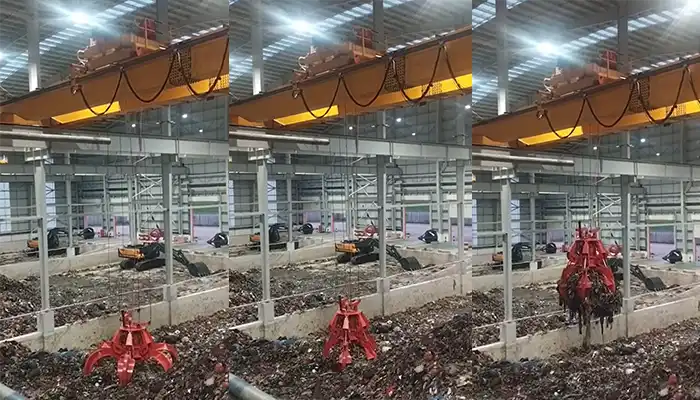
Supplied three grab bucket crane kits to Indonesia, enhancing garbage handling efficiency with high load capacity and reliable performance.
Free consultation to Confirm Parameters & Specifications and Get
Latest Crane Price & Crane Rate.
- Types of overhead cranes : _______?
- Optional: Overhead travelling crane, goliath gantry crane,Slewing jib crane, Single girder or double girder crane,small portable crane or kbk crane, etc.
- Capacity of overhead crane: _______?
- Optional: 0.25ton, 0.5 ton, 1 ton, 2 ton, 3ton, 5 ton, 10 ton,15ton, 20ton, 25 ton, 30ton,35ton, up to 550ton, etc.
- Crane span & lifting height : _______?
- Crane travelling length : _____?
- Control of overhead crane:_______?
- Optional: pendant/ remote/cabin control
- Voltage supply of overhead crane:_____?
- Eg,: 380V50/60HZ,3Phase or others,etc.
- Application/usage of crane:_______?
- Eg,: Steel mill, ,injection mold, cement,stone, concrete,granite, general manufacturing, etc.
Just leave a message via the contact form and our hoist and crane engineer will contact you with in 24working hours.
Get In Touch
